Inbox and Environment News: Issue 403
May 5 - 11, 2019: Issue 403
Rain
I woke up this morning and looked out the back.
The sky is full of dark clouds, it looks very black.
Unfortunately it's been like that for a week
For ****** sake what have we got to do to break this dry streak.
Frogs are not croaking, I've not seen an ant.
No Stormhawks or Rainbirds, not heard a chant
Will someone hold a Garden Wedding, that will bring rain
Send it down Huey. We need to grow Grain.
Ken 'Sava' Lloyd
May 3rd, 2019
Gunnedah, N.S.W.
Local Shark Net Toll
The 2017/2018 shark net season saw 64 marine animals entangled in nets on the Northern Beaches, including harmless and endangered species of sharks, rays, turtles and dolphins. Overall 403 marine animals died from being entangled in nets in NSW.
The Humane Society of Australia and the Australian Marine Conservation Society are calling on the NSW Government to invest in non-lethal alternatives.
A Petition is currently being circulated by these two organisations, which reads:
Dear NSW Premier and Minister for Fisheries,
I abhor the use of shark nets by the NSW Government. These death traps are catching and killing hundreds of marine animals every year and provide nothing more than a false sense of security to the public.
Recent images of Endangered scalloped hammerhead sharks caught in nets at Sydney’s Palm Beach have driven me to write to you asking that the nets not be reinstalled again in NSW.
These outdated nets have been used since the 1930s, but your own data shows that there have been 33 human-shark interactions at beaches with nets.
Instead of nets, I support the use of drone technology, personal shark deterrents, alert systems and education as the main tools to reduce risk of shark bite.
There is no place for these nets anymore. The cost of the nets is too high on our marine wildlife without any benefit to ocean users.
I will be watching when the 2018/2019 shark net catch data from NSW is released later this year and I hope it’s the last set of data of its kind.
______________________________
NB: Due to the distressing nature of the images of Endangered scalloped hammerhead sharks caught and drowned in nets at Palm Beach they have not been included in this report.
Hands Across The Sand Against 3D Seismic Testing Protest At Manly
Hosted by Surfrider Foundation Northern Beaches
Against 3D seismic testing and oil and gas exploration off our coasts.
Hands Across The Sand peaceful protests are occurring at Umina Beach at12 this Sunday 5th May, Woollongong Beach at 10am and next week it will be Northern Beaches turn on Manly at 3pm Saturday 11th May - meet at the north end of beach - line will go from the Corso to north.
Updates posted here: https://www.facebook.com/surfridernb/
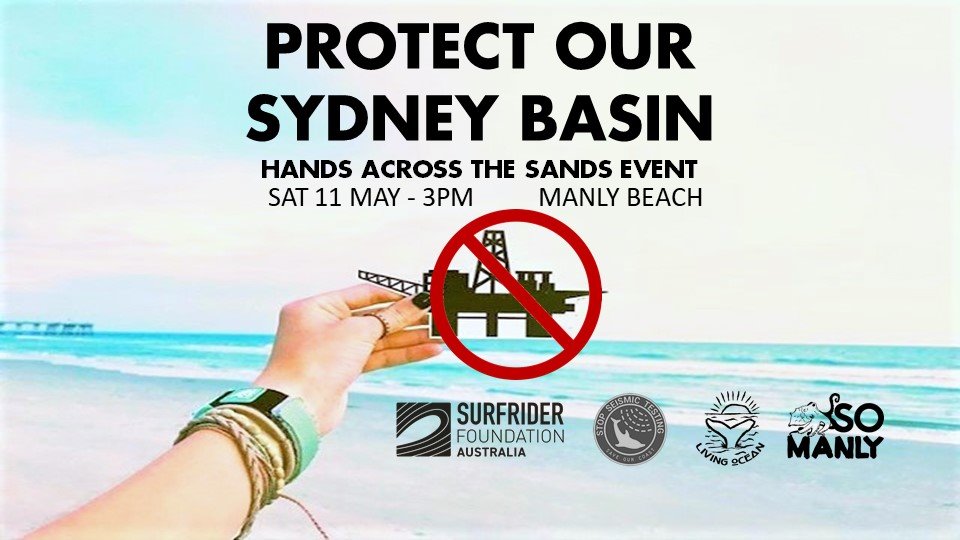
Grevillea Caleyi Bushcare May 2019
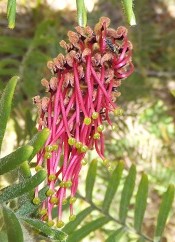 Next volunteer bushcare day will be on Monday the 27th of May, 2019.
Next volunteer bushcare day will be on Monday the 27th of May, 2019.Meet at the picnic shelter at 8.30 am
New volunteers welcome - training will be provided
Wear long trousers, a long sleeved shirt and boots or closed in shoes
The session will be cancelled in the event of rain. For more information contact David Palmer on 0404 171 940.
Please join our Bush regeneration morning at the Baha'i Temple, 173 Mona Vale Road Ingleside.
Based on our past success PNHA has been given a new round of funding to continue work on conserving the threatened Grevillea caleyi - so we look forward to your support.
Morning Tea provided.
Pittwater Natural Heritage Association
Annual Zero Bag Limit Commences May 1 – Australian Bass And Estuary Perch
April, 30th 2019: NSW DPI
Fishers are being reminded that the annual zero bag limit closure for Australian Bass and Estuary Perch from all rivers and estuaries in NSW will commence on 1 May.
NSW Department of Primary Industries (NSWDPI) Senior Fisheries Manager Inland, Cameron Westaway, said the closure protects the fish species during their spawning period.
“During the winter months these popular native sports fish species become vulnerable to overfishing as they form large groups and migrate to parts of estuaries with the right salinity to trigger spawning,” Mr Westaway said.
“The zero bag limit protects the fish species while they spawn and ensures they can remain a popular catch with recreational fishers for many generations to come.”
Catch and release fishing for Australian Bass or Estuary Perch is permitted in rivers during the closure but any of these species of fish must be returned to the water immediately with the least possible harm.
“The zero bag limit does not apply to Australian Bass and Estuary Perch caught in freshwater dams or in rivers above impoundments, as they do not breed in these areas,” Mr Westaway said.
“No waters are closed to fishing and the zero bag limit does not affect anglers fishing for other estuary species, such as bream or flathead.”
Mr Westaway said fish in freshwater impoundments, like Glenbawn Dam and Glennies Creek Dam in the Hunter Valley, Brogo Dam near Bega and Clarrie Hall and Toonumbar Dams in the northeast are stocked fisheries, meaning anglers may continue to fish for these species in those waters all year round.
The zero bag limit ends on September 1, and Fisheries Officers will target anglers illegally retaining Australian Bass or Estuary Perch during the four month closure.
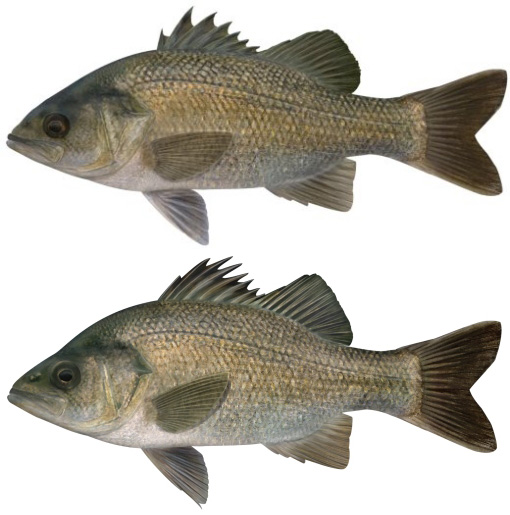
The bass and perch are very similar, having a greyish skin colour. Differences in the dorsal fins stand them apart.
Australian Bass (top) and Estuary Perch
Trout Spawning Season Starts May 1st
April 29, 2019: NSW DPI
Anglers in the Snowy Mountains are reminded that the annual trout spawning season commences in the region from Wednesday May 1st, 2019.
NSW Department of Primary Industries (NSWDPI) Senior Inland Fisheries Manager, Cameron Westaway, said the annual trout spawning season fishing rules apply to the Thredbo River and its tributaries and the Eucumbene River and its tributaries (upstream of the Lake Eucumbene dam wall and including Providence Portal).
“Restrictions are in place to provide protection for early spawning brown trout,” Mr Westaway said.
“The restrictions also provide fishers with the opportunity to catch a trophy sized trout – in particular the Eucumbene River has provided excellent fishing for large brown trout over the past few years.”
A minimum size limit of 50cm, daily bag limit of one and possession limit of two trout will apply to these rivers from 1 May to the end of the Queen’s Birthday long weekend on Monday 10 June 2019.
“Anglers can use one attended rod and line with up to two hooks with artificial flies or lures and up to three treble hooks attached to any lure is permitted, while any fishing gear rigged for bait fishing is prohibited,” Mr Westaway said.
The annual closure on fishing in trout streams for the rest of NSW will be in place from Tuesday 11 June 2019, allowing brown and rainbow trout to breed uninterrupted until the trout fishing season re-opens on the October long weekend on Saturday 5 October 2019. Trout dams remain open to fishing throughout the year.
“When the season opens again in October, a minimum size limit of 25cm, daily bag limit of two and possession limit of four trout will again apply to the Thredbo and Eucumbene Rivers,” Mr Westaway said.
“DPI, in conjunction with local acclimatisation societies, has been stocking trout dams and rivers in NSW for many years, however it is important to provide increased protection for brown and rainbow trout during their annual spawning runs.”
Fisheries officers will be patrolling the Thredbo and Eucumbene Rivers to ensure that fishers are abiding by these rules.
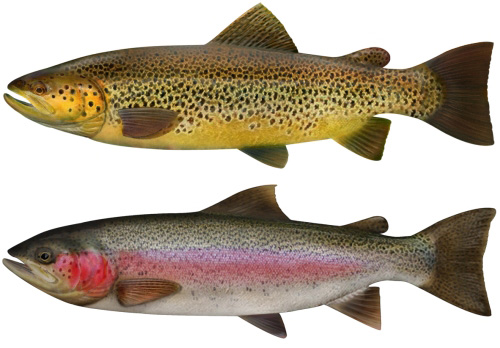
Brown trout (top) and Rainbow trout
Sydney Wildlife Carers Course May 2019
Scratchum the Brushtail possum was found in the middle of the day sitting in a puddle outside a petrol station on King st, Newtown.
A lovely person spotted her, scooped her up, kept her warm in their jacket and walked to the vet.
The little one was very dehydrated and cold.
If still in the wild she would be in her mum’s pouch and riding on her back at night. We aren’t sure how they were separated.
One of our volunteers soon picked Scratchum up and has been caring for her ever since.
Scratchum is doing very well, she loves her marsupial formula and has started eating solids. In a few months Scratchum will be ready for release!
Our next Rescue & Care course is 18-19 May 2019. If you want to help in the rescue and rehabilitation of our wildlife go to the following link to register: www.sydneywildlife.org.au/upcoming-courses.html
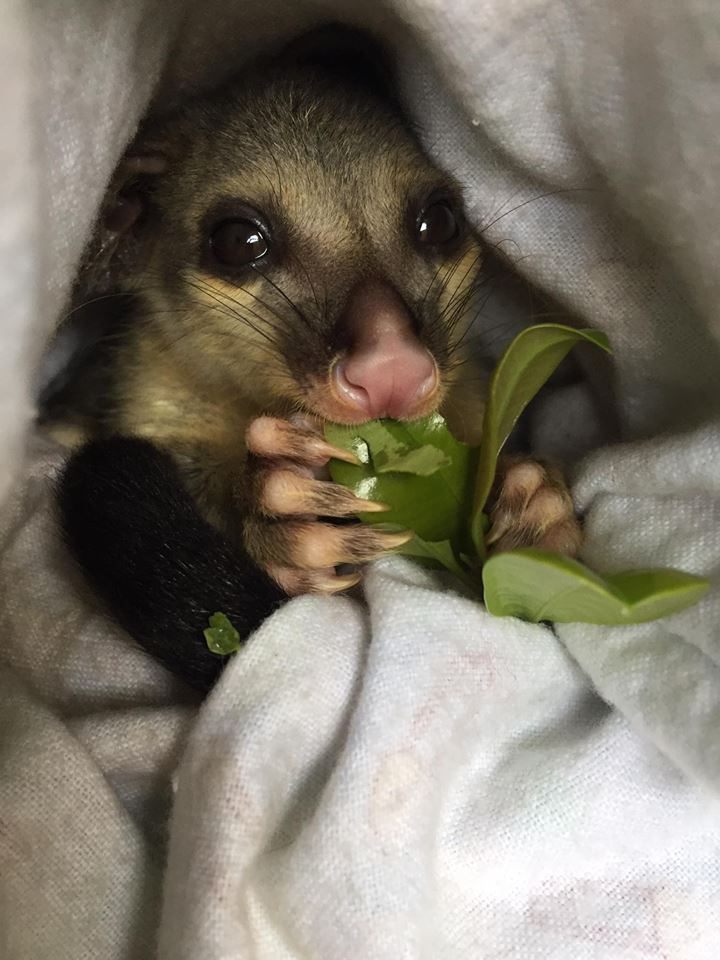
Scratchum
Organics Collections Grants Now Open
Applications are now open for Round 7 of the Organics Collections grants.
Aims
This eight-year, $27 million program funds new or improved local council household kerbside collection services for food and garden organics, including collection systems for garden only, food waste, or a combination of both.
How to apply
Grants of up to $1.3 million are available for bins, kitchen caddies and education for councils (or groups of councils) to introduce new food and garden waste collection services. Funding is also available for trials and system roll outs for source separated organics collections in multi-unit dwellings.
Businesses and councils with projects that involve collection of food waste from businesses are also eligible for funding, with up to $500,000 available for 50% of the cost of collection vehicles, bins and expert advice.
A webinar detailing how to apply for will be held on Wednesday 15 May 2019 at 2.30 pm. Register for the webinar.
Applications close at 3pm on 27 June 2019.
More information, the application form and guidelines are available from the NSW Environmental Trust.
New Clues To Coastal Erosion
May 2nd, 2019: Flinders University
New research has uncovered a missing nutrient source in coastal oceans, which could promote better water quality and sand management on popular beaches.
While the release of nutrients buried in the seabed 'feeds' coastal marine ecosystems, the latest research at Flinders University has found a new physical mechanism which erodes seabed sediment at depths up to 20 metres, well outside (between 10km and 20km) from the surf zone closer to shore.
This powerful natural process that is energetic enough to erode seabed sediment at up to 20 m, also adds to the nutrients stirred and moved by breaking surface waves nearer the beach, according to the new hydrodynamic modelling.
"This new knowledge has significant implications for coastal sediment management practices such as dredging," says Flinders University oceanographer Associate Professor Jochen Kaempf.
The study reveals that major sediment erosion follows from coast-parallel winds in an oceanic situation known as downwelling.
"Such winds trigger a swift coastal current -- left-bounded by the coast in the Southern Hemisphere -- that is accompanied by a vigorous stirring zone in nearshore waters," Associate Professor Kaempf says.
While this finding explains the high proportion of recycled nutrients in coastal ecosystems, it incidentally also points to a new mechanism of wind-driven sediment drift in coastal oceans that complements the well-known littoral drift in the surf zone.
"Along the Adelaide metropolitan coastline, for example, the wind-driven sediment drift tends to be predominantly southward and opposite to the northward sediment drift in the surf zone," explains Dr Kaempf.
"On the other hand, high turbidity levels following a seabed erosion event negatively impact the health of seagrass beds, and the sudden nutrient release can also trigger potentially harmful toxic algae blooms," says Dr Jochen Kaempf, who also is South Australian branch president of the Australian Meteorological and Oceanographic Society.
Dr Kaempf's latest paper calls for more field research and the development of reliable ocean forecasting models to study and predict the occurrence of such erosion events.
Jochen Kämpf. Extreme bed shear stress during coastal downwelling. Ocean Dynamics, 2019; 69 (5): 581 DOI: 10.1007/s10236-019-01256-4
Australian Blue Tongue Lizard Ancestor Was Round-In-The-Tooth
May 1, 2019: Flinders University
Reconstruction of the most complete fossil lizard found in Australia, a 15 million year old relative of our modern blue tongues and social skinks named Egernia gillespieae, reveals the creature was equipped with a robust crushing jaw and was remarkably similar to modern lizards.
A new study lead by Flinders University PHD student Kailah Thorn, published in the journal of Vertebrate Palaeontology, combined the anatomy of of living fossils with DNA data to put a time scale on the family tree of Australia's 'social skinks'.
"This creature looked like something in-between a tree skink and a bluetongue lizard. It would have been about 25 cm long, and unlike any of the living species it was equipped with robust crushing jaws," says Ms Thorn.
The results show that our Australia's bluetongue lizards split from Egernia as early as 25 million years ago.
"The new fossil is unusually well-preserved, with much of the skull, and some limb bones, all from a single individual. It belongs to the genus Egernia, a modern species in this group which are often called 'social skinks' and are known for living in family groups, sharing rocky outcrops and hollow tree stumps."
Remarkably similar to modern social skinks, E. gillespieae instead is equipped with rounded crushing teeth and a deep, thick jaw.
The fossils are from the Riversleigh World Heritage fossil deposits in northwest Queensland, and were named after Dr Anna Gillespie, a UNSW palaeontologist responsible for preparing many of the spectacular fossils from that area.
"I have been preparing the Riversleigh fossil material for quite a few years now and lizard bones are rare elements. When the jaw appeared and was quickly followed by associated skull elements, I had a good feeling it would be a significant addition to the Riversleigh reptile story," says Dr Gillespie.
Kailah M. Thorn, Mark N. Hutchinson, Michael Archer, Michael S. Y. Lee. A new scincid lizard from the Miocene of Northern Australia, and the evolutionary history of social skinks (Scincidae: Egerniinae). Journal of Vertebrate Paleontology, 2019; e1577873 DOI: 10.1080/02724634.2019.1577873
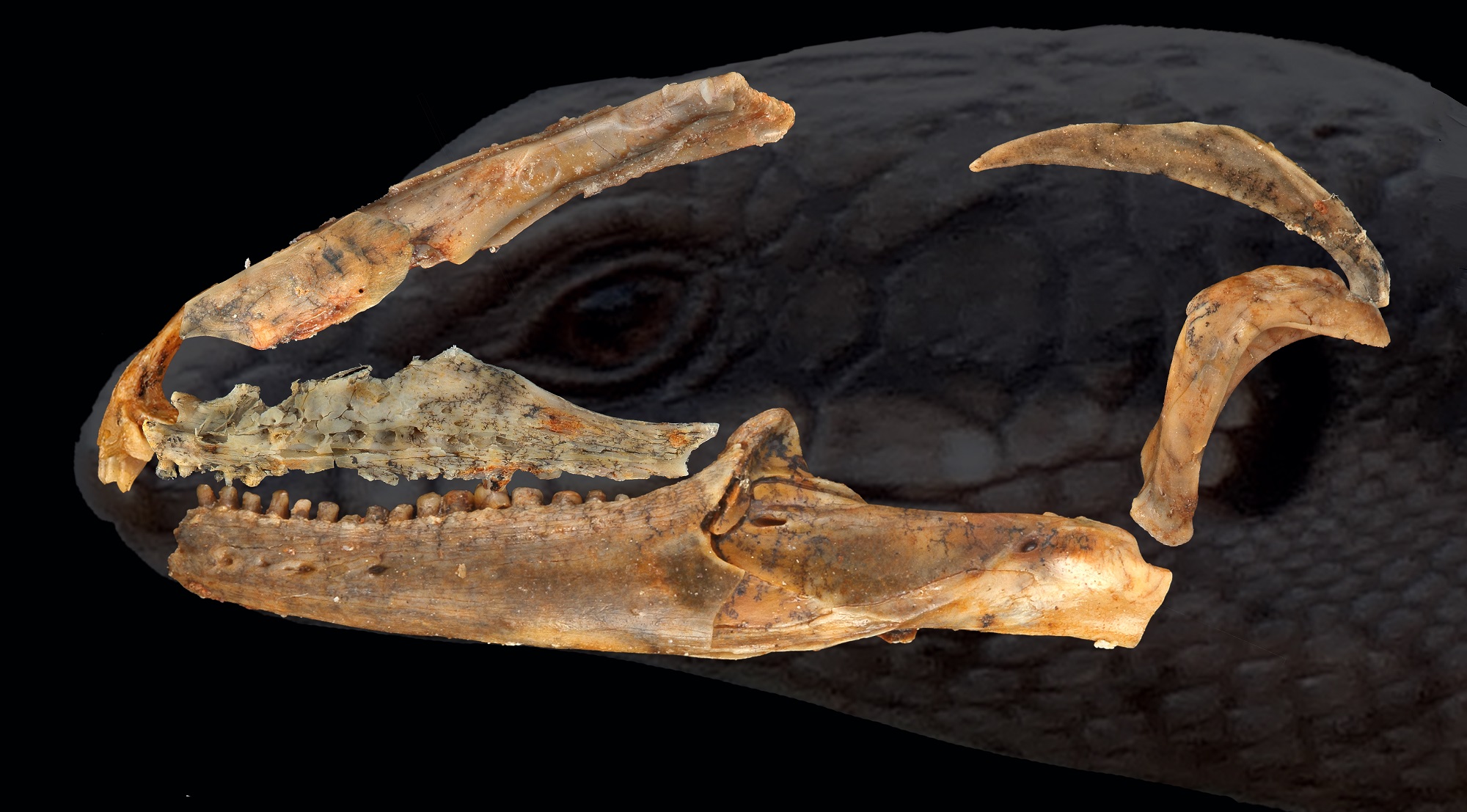
The reassembled skull bones of Egernia gillespieae, a 15 million year old skink from Riversleigh World Heritage Area of northwestern Queensland
Crookwell 3 Wind Farm Referred To IPC
May 2nd, 2019: Departmental Media Release - NSW Department of Planning and Environment
The Department of Planning and Environment has referred Crookwell 3 Wind Farm to the Independent Planning Commission (IPC) for final decision, saying it should be refused due to significant cumulative visual impacts on the landscape and residents.
Mike Young, Executive Director of Resource Assessments, said the proposal is for the construction and operation of a new wind farm with 23 turbines up to 157 metres in height approximately five kilometres from Crookwell in the Southern Highlands.
“There’s strong support for renewable energy in NSW and the Government is backing the industry’s development including with guidance on assessment of impacts, community engagement and more,” he said.
“We considered this project on its merits, and our recommendation to refuse it draws on extensive community consultation and advice from an independent visual expert.
“The proposal is right next door to the Crookwell 2 Wind Farm, built by the same proponent. Some people would be able to see five wind farms from their front door.
“When it comes to visual impact, lots of factors need to be considered – from windfarm distance to residential areas to distracting blade glint and turbine flicker.
“We acknowledge the proponent has made changes to reduce impacts and has reached agreement with a number of landowners, but our independent visual expert has advised there would still be significant visual impacts on up to 27 residences.
”Mr Young said the NSW Wind Energy Framework, introduced by the NSW Government in 2016, set clear and consistent rules for wind farm development.
“The Framework recommends turbines this size should be more than 2.1 kilometres from residences, but in this case 17 of the 23 proposed turbines are less than that,with some residences as close as 1.1 kilometre.
“The proposal is also inconsistent with local planning controls, which classify more than two-thirds of the proposed site as an environmental management zone. Overall,our assessment concluded the site is fundamentally not suitable for a large-scale wind farm.
The IPC will review the Department’s assessment before making its final decision. Read the Department’s assessment report and reasons for refusal of the proposed Wind Farm at the Department’s Major Projects website.
As at 9 April 2019:
- There were thirteen major operating wind farms in NSW, with a total capacity of about 1400 MW.
- Four new wind farms were commissioned in 2018-19:
- The 270 MW Sapphire wind farm is the largest in NSW and can provide enough electricity to power over 131,000 NSW homes.
- The 199 MW Silverton 1 wind farm can provide enough electricity to power over 96,000 NSW homes.
- The 172 MW White Rock 1 wind farm is the second largest in NSW and can provide enough electricity to power over 80,000 NSW homes.
- The 92 MW Crookwell 2 wind farm was also commissioned, which can generate enough energy to power almost 45,000 homes.
- Two wind farms were under construction, amounting to about 250 MW and worth $500m in investment.
- 11 wind farms had planning approval, almost 2,600 MW and worth about $4bn and 6 wind farms were seeking planning approval, over 1,350 MW and worth around $1.5bn in investment.
Mark Foy's Fashions - Mash Up
Published May 2nd, 2019 by NFSA
From The Film Australia Collection. To celebrate the launch of the NFSA's new Dressmaker Costume Exhibition and our new Vintage Fashions online curated collection we present this mash up from the Mark Foy's Fashion Collection (1940s to 1950s). This collection of 16mm film was donated to Film Australia over 20 years ago and is now part of the NFSA collection.
Recently scanned to HD digital files it represents a unique insight into the high-end fashion world of Sydney in the 1940s and 1950s. The collection showcases three events held at Mark Foy's department store over ten years where French designers and models brought Paris haute couture to the streets of Sydney. These films are originally silent and the collection contains over two hours of material. It is presented here with contemporary audio and effects.
Also available:
Reflections by George Repin - CITY DEPARTMENT STORES – GONE AND MOSTLY FORGOTTEN
Young Archie Finalists 2019
There were over 2100 entries in this seventh Young Archie competition: 33% in the 5-8 year category, 44% in 9-12 year, 17% in 13-15 year and 6% in 16-18 year. Of the total, 74% were from girls.
The ten finalists from each age category are displayed at the Art Gallery of NSW and the honourable mentions at the SH Ervin Gallery. Winners will be announced on 10 August 2019.
The competition was judged by the Gallery’s community engagement manager and the guest judge – artist Marikit Santiago, herself an Archibald Prize finalist in 2016.
The Young Archie competition is supported by presenting partner ANZ and S&S Creative.
A few examples:
Finalist: 5-8 year olds
Ian Joseph Kim
Age: 7
Title: Sing to joy
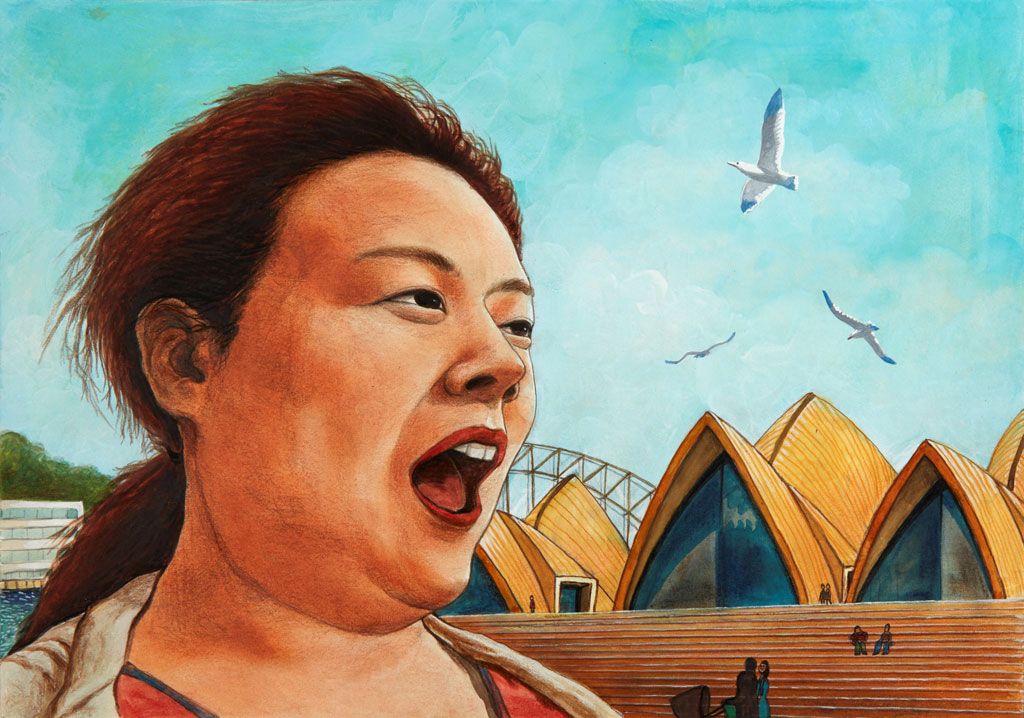
Artist's Statement: Last January, my family visited the Sydney Opera House and my mum sang a song near the stairs. My mum’s dream was to be an opera singer, but she couldn’t. She still dreams of singing opera on the stage of the Opera House. I like my mum’s singing and I wish her dream would come true one day. That’s why I drew my mum singing in front of the Opera House.
Finalist: 9-12 year olds
Callum Macgown
Age: 11
Title: Grandpa's eyebrows
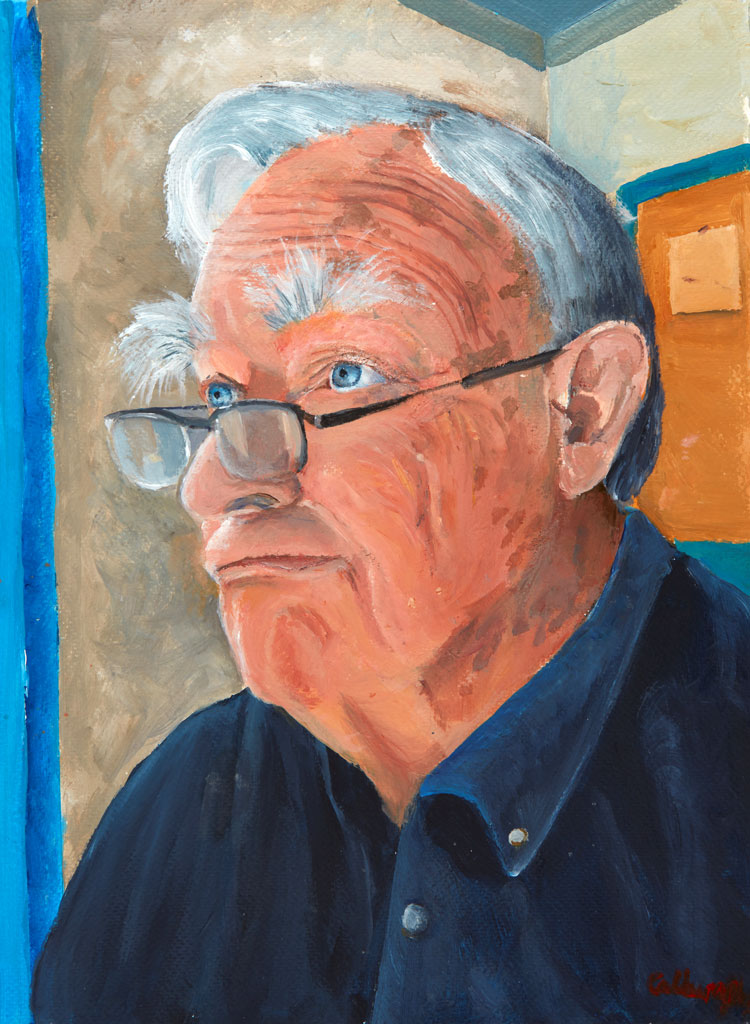
Artist's Statement: Grandpa’s eyebrows are very long and extraordinarily impressive. They show the flamboyant side of his character, but he has many facets. He is a very interesting, cheeky person. He thinks deeply and it is hard to understand what he is thinking from the expression on his face. Sometimes he is filled with dark thoughts from his rich imagination. With that imagination comes an amazing writer. We share a love of writing. I love Grandpa very much.
Finalist: 13-15 year olds
Lily Norman
Age: 15
Title: Johnny
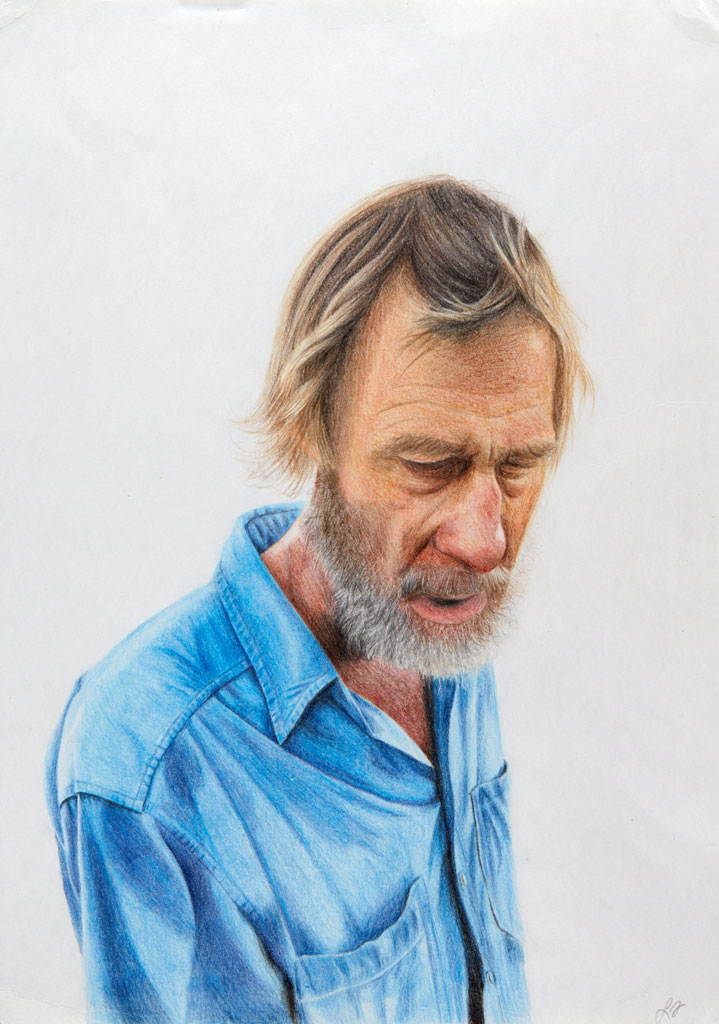
Artist's Statement: Johnny is a shy, unassuming yet colourful character, well known in our community as a passionate environmentalist and advocate for getting kids into the garden. He is generous with his time, sharing his knowledge on how to live more consciously. He has spent many hours in our garden teaching my sister and me, along with all the neighbourhood kids, about native and edible plants and how to nurture our land.
Finalist: 16-18 year olds
Madeline Power
Age: 16
Title: Two sides of the same coin
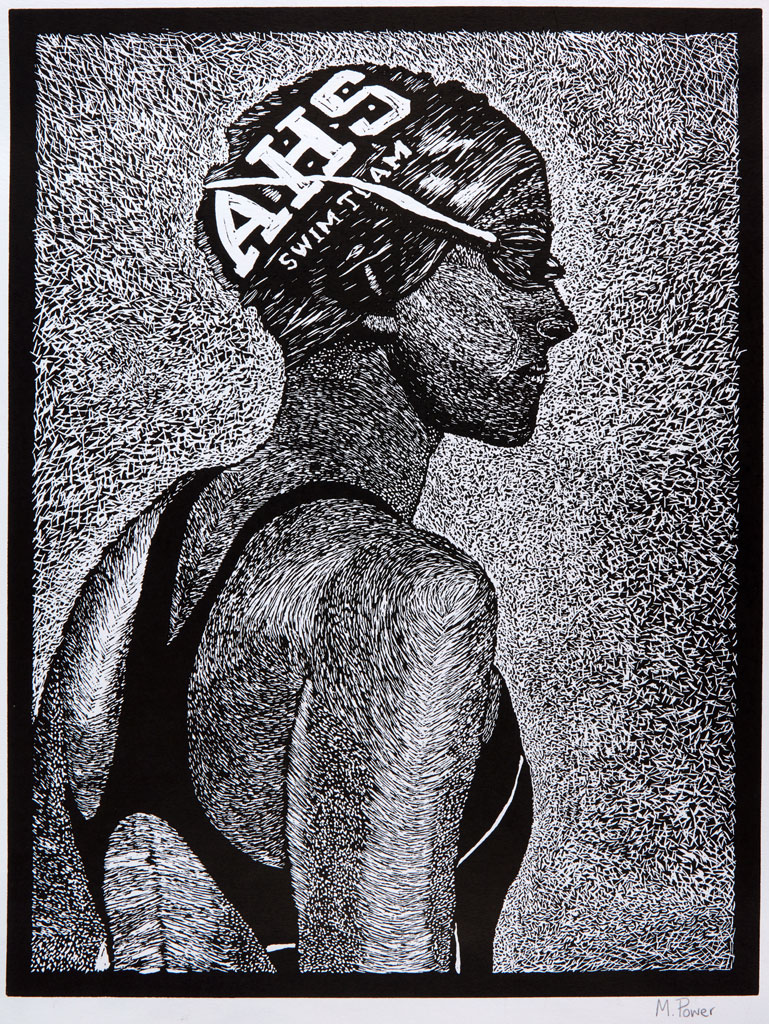
Artist's Statement: Everyone knows the idiom ‘two sides of the same coin’. These words are the inspiration behind my portrait of a person who is special to me and integral to my life. My portrait illustrates a person who is confined to an aqueous surrounding of silence. All emotions are narrowed down to one thin black line, consumed by the result of hours of relentless training, torn, stretched, beaten muscles, early mornings and the pure desire to win. This is someone who only emerges a mere second before the starting gun. This is me.
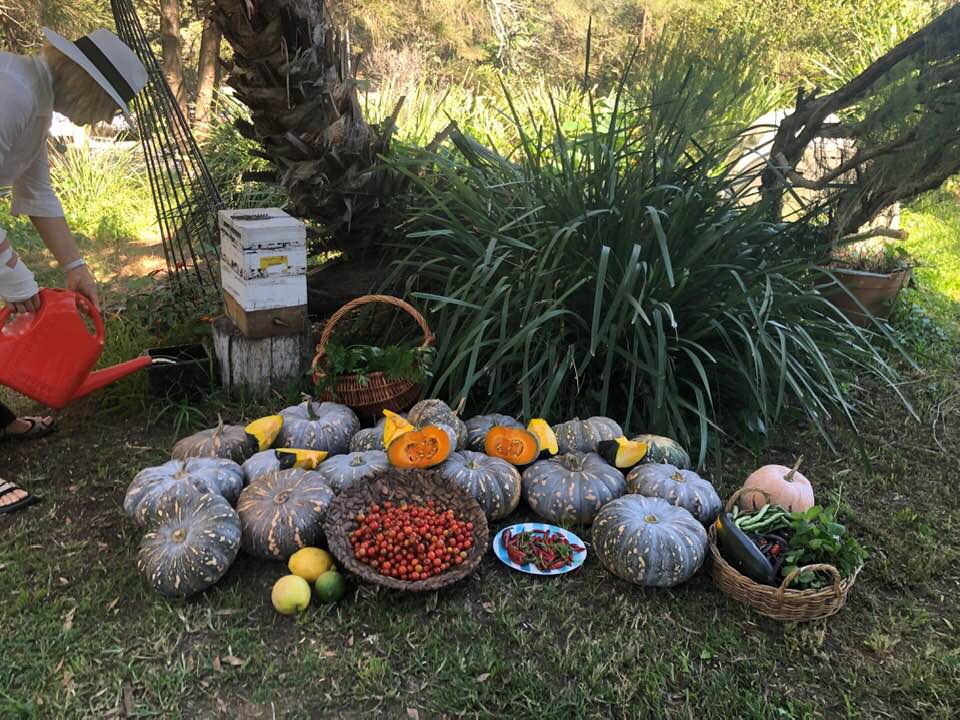
Fantastic People Creating All Good Things at Avalon Community Gardens - April 28, 2019. Photo by Geraldene Dalby-Ball
Why We Need World Press Freedom Day
April 29, 2018
Byline: Peter Fray, University of Technology, Sydney (UTS) FASS
No one going into journalism should expect to be universally loved. That’s not the job. But neither should journalists and media workers live in fear of being killed, assaulted or arrested for simply doing that job.
The first casualty of war is truth. But not far behind on the list are the truth seekers. There is a war on truth going on — and the bad people appear to be winning.
Both actual and symbolic violence against journalism is on the rise. Last year, 94 journalists and media workers were killed carrying out their job, up 12 on the previous year, according to the International Federation of Journalists (IFJ).
Some deaths gain international prominence.
International ramifications continue, for instance, from the murder of Washington Post columnist, Jamal Khashoggi, inside the Saudi consulate in Istanbul.
And many serve as the spark to action. The recent killing of journalist Lyra McKee, 29, in Northern Ireland has served to unite that community against the sectarian violence that scarred their lives for decades – and many thought was over.
Why did she die? Her killers, the New IRA, apologized to McKee’s family and said she was killed “while standing beside enemy forces”. The truth is she was killed for doing her job — bearing witness.
But most journalists’ deaths leave the news cycle in a day or so. The dead would understand that reality. But on World Press Freedom Day on May 3rd, we have the chance to reflect on the price paid by these individuals, their families, friends and colleagues. And do something about it.
By naming The Guardians and the War on Truth as its person of the year in 2018, Time magazine confirmed what most journalists know: it is getting harder to do your job — harder in multiple ways. Journalism needs your support.
There are direct and indirect ways to do that. Locally, Media Solidarity and Safety Fund works to make journalism safer; globally, the Committee to Protect Journalists does much the same thing, as does the IFJ.
But there are others ways we can assist truth seekers. Much of the violence against journalism is symbolic. Calling journalists “the enemy of the people” and purveyors of ‘fake news” are the most obvious example.
As I said at the beginning, journalists don’t expect to be loved. But the vast majority work to serve two masters – one, their employer, and secondly, the public good. And the vast majority have a bias towards truth.
I am the first to admit that journalism isn’t perfect. But it is not the purveyor of fake news and journalists are not the enemy of the people.
So, please don’t undermine journalism and fuel those who attack it by sharing news that doesn’t come from a verified and reputable source. Don’t add to the mountains of fake news out there already.
Fortunately, Australia’s political leaders are less prone to inspire dislike against journalism – but they are not immune.
Here, for example, is the Labor chief minister of the ACT, Andrew Barr, early in 2018: “I hate journalists. I’m over dealing with the mainstream media as a form of communication with the people of Canberra.”
He later backed off, a little, but the damage was done: more “hate” against journalists.
At UTS, we are taking steps to help the fight against the spread of misinformation – and enhance the trust in journalism.
In time for the current Federal election, the Centre for Media Transition has launched the Asia Pacific bureau of the First Draft News, a global collaborative project which aims to research and expose the misinformation network and assist journalists and students learn the skills to do so. More information about First Draft can be found here.
There is much that can and will be done. On this World Press Freedom Day, we, at the Centre for Media Transition, salute journalists the world over for holding the powerful to account and bearing witness to the events, issues and people who shape our communities.
We hope you will too.
The Centre for Media Transition at UTS explores news media regulation and press freedom; news media best practice; and new business models for journalism. Peter Fray is the centre’s co-director.
Port Kembla Gas Terminal Gets Planning Approval
April 29, 2019: NSW Government
The NSW Government has given planning approval for Australian Industrial Energy to construct the gas terminal at Port Kembla.
The new terminal will accommodate Liquefied Natural Gas (LNG) carrier ships, a floating LNG handling facility, wharf infrastructure and a pipeline to connect to the existing NSW east coast gas network nearby.
Once operational, the terminal could supply 70 per cent of the state's annual gas demand and help to ease the cost of energy bills for the 33,000 businesses and a million households in NSW that depend on natural gas.
With the creation of 150 jobs during construction and up to 50 ongoing roles once operational, the terminal is also a major boost for the economy.
Before approving the terminal, the NSW Government assessed the environmental, social and economic impacts identified by community, government and independent stakeholders.
Planning approval includes conditions to:
- manage impacts during the construction of the import terminal, including excavation and dredging activities in Port Kembla harbour and management of contaminated materials and acid sulphate soils
- manage hazards and risks associated with the operation of the LNG import facility and gas pipeline
- regulate and monitor air and water discharges from the project during construction and operations.
Minister for Energy and Environment Matt Kean said the Port Kembla gas terminal will be a game-changer for improving energy security and helping to ease energy costs.
“It could support gas-fired electricity generation in NSW and help make sure we have reliable electricity.”
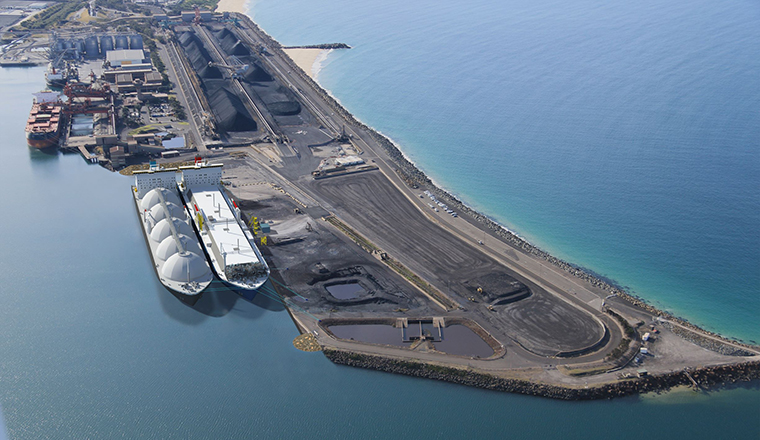
Illustration of the new 250 million Port Kembla gas terminal.
Fat Cell Discovery Could Help Combat Obesity-Related Health Issues
April 30, 2019: University of Melbourne
Researchers have discovered differences in fat cells that could potentially identify people predisposed to metabolic diseases such as diabetes and fatty liver disease.
The world-first discovery also identified 'fast burning' fat cells that if unlocked might help people lose weight.
About 70 per cent of Australians are overweight or obese, which has been linked to metabolic disease risk. The University of Melbourne, Australia, research found that an individual's level of risk might depend upon the type of fat they store.
Published in Cell Reports, the study took samples from human volunteers and discovered three specific subtypes of precursor cells that went on to become fat cells.
The first released lots of fat into the bloodstream, the second burned energy at a high rate and the third was 'rather benign' and did what a fat cell should normally do but slowly.
All three cell subtypes were present in fat tissue throughout the body, and not confined to a particular part. All were present in all fat samples. Some people had more of some cell subtypes and less of others.
Senior author Matthew Watt, who is Head of Physiology in the University of Melbourne's School of Biomedical Sciences, said the results indicated that the makeup of these cells in a person's body could help to determine their health.
Professor Watt said the first subtype might increase the risk of fatty deposits around the body and on organs, regardless of whether they were overweight or not, while the second could possibly prevent weight gain. The third was neutral.
While it is early days, he said further research could potentially determine ways to 'switch off' the fat releasing cells and 'switch on' the fat burning cells. This would involve developing drug therapies and could take at least 10 years.
Professor Watt said if developed, such treatments could help prevent some illnesses and and be less invasive than bariatric surgery. But they should also involve lifestyle changes.
"Whilst we advocate new discoveries to inform the development of anti-obesity therapies, a healthy lifestyle, including daily activity and reduced food intake, is also important," he said.
Professor Watt's team separated different cell types, investigated their genes and assessed proteins and metabolism. They found three subtypes of fat cells, which are also known as adipocyte progenitor cells (APCs).
"The discovery is important because it tells us that not all fat cells are the same and that by understanding the fat subtypes in a human, we might be able to predict their future metabolic health," Professor Watt said.
While the results indicated certain cell subtypes might increase risk of metabolic disease, Professor Watt said a clinical trial was now needed to accurately answer that question. At this stage it was not practical to routinely test fat composition.
"This requires very detailed and expensive tests," Professor Watt says. "Until we show a link between certain fat cells and health traits this will not be a useful test.
"We first need to determine whether the number of the fat cell subtypes affects disease development. Then we can work out ways to decrease or increase a certain type of fat cell type to improve health, but again this will require further experimentation."
Arthe Raajendiran, Geraldine Ooi, Jackie Bayliss, Paul E. O’Brien, Ralf B. Schittenhelm, Ashlee K. Clark, Renea A. Taylor, Matthew S. Rodeheffer, Paul R. Burton, Matthew J. Watt. Identification of Metabolically Distinct Adipocyte Progenitor Cells in Human Adipose Tissues. Cell Reports, 2019; 27 (5): 1528 DOI: 10.1016/j.celrep.2019.04.010
Vaccinate Against Flu Now
May 1st, 2019
Pregnant women, young children and the elderly will be a major focus of this year’s Winter Flu Campaign, officially launched today.
Premier Gladys Berejiklian said free vaccines were available for those most vulnerable, including pregnant women, those over 65 years old, and anyone with medical conditions such as asthma, diabetes, and heart disease.
“More than one million flu vaccines have now been delivered across the State with more to come, so now is the best time for you to get vaccinated,” Ms Berejiklian said.
“The vaccine is very safe and cannot give you the flu. Best of all, it is free for those most vulnerable and offers them the best protection.” Ms Berejiklian and Health Minister Brad Hazzard launched the campaign at Blacktown Hospital’s antenatal clinic, where expectant mums were getting their flu shots to protect themselves and their babies.
“Getting a free flu shot is the best protection for expectant mums and will help protect newborns in their first few months of life. It also the best protection for young children,” Mr Hazzard said.
Hospital admission rates for influenza are highest in young children, with recent national figures showing about 100 per 100,000 in those aged six to 23 months. There have been more than 9,600 confirmed influenza cases in NSW already this year across all age groups.
The NSW Government has invested about $130 million in the 2018-19 Immunisation Program budget, including Commonwealth and state vaccines. Free flu vaccines for children aged from six months to under five years of age are available under the NSW Government’s $2.6 million program.
Experts recommend sneezing into your elbow, washing your hands regularly and staying home when sick to reduce the spread of flu.
“Last year, we avoided a repeat of the bad 2017 flu season, but we cannot be complacent so please, go get your flu jab,” Mr Hazzard said.
Your Genetic Make-Up Has Little Impact On Your Dental Health
April 30, 2019: University of Melbourne
A new study has found genetic makeup does not predispose people to tooth decay, however the research did find that children with overweight mothers are more likely to have cavities.
The paper, published in the latest edition of Pediatrics, estimates that one in three Australian children have tooth decay by the time they start school.
Lead researcher Dr Mihiri Silva, from the Murdoch Children's Research Institute, said the study looked at the teeth of 173 sets of twins (identical and non-identical) from pregnancy through to six years of age.
"How genetics impacts on dental health has not often been studied," Dr Silva said. "This is the first twin study that looks at both genetics and early life risk factors, such as illness and lifestyle.
"We found that identical twins, with identical genomes, have varying degrees of decay. "This means that environmental factors, like a lack of fluoride in water, seem to be the prime cause of cavities not genetic makeup."
However Dr Silva said the research did find a link between the mother's health and lifestyle during pregnancy and the child's future dental health, with obesity in pregnancy a definite marker for increased risk of child tooth decay.
"The relationship between maternal obesity and child tooth decay is complex," Dr Silva said. "Perhaps the mother's weight has a biological influence on the developing fetus or perhaps the risk of decay rises because of increased sugar consumption in that household."
One in three of the twins studied (32.2 per cent) had dental decay, and almost one in four (24.1 per cent) had advanced decay.
Dr Silva said it was important that people don't think of tooth decay as genetic.
"If people think the health of their teeth is down to their genetic make-up, they may not be prepared to make important lifestyle changes," she said.
"Our findings also reinforce how important it is for pediatricians and other health professionals to educate children to start preventive measures early in life, prior to the onset of damage to dental tissues."
Dr Silva said tooth decay was a serious health problem, because there was a clear link between child cavities and developing diabetes and cardiovascular disease later in life.
"Tooth decay is also the leading cause of preventable hospital stays for Australian children," Dr Silva said.
(According to 2011 Victorian (Australia) Department of Health statistics, more than 26,000 Australians under the age of 15 are admitted to hospital to treat tooth decay every year.)
Dr Katrina Scurrah, from Twins Research Australia and the School of Population and Global health at the University of Melbourne (Australia), said the study illustrated the advantages of studying twins to find out about health conditions and the importance of considering the effects of early life risk factors as well as genes.
But she said it's important to try to replicate these findings in other studies that follow children through to adulthood and to explore other risk factors for dental decay.
This latest study in Pediatrics collected data about the twins at 24 and 36-weeks' gestational age, at birth, 18 months and six years of age. This included a dental examination at age six.
Questionnaires about the mother's weight, illnesses, medication use, vitamin D levels, stress, alcohol intake and smoking were collected during pregnancy.
Mihiri J. Silva, Nicky M. Kilpatrick, Jeffrey M. Craig, David J. Manton, Pamela Leong, David P. Burgner, Katrina J. Scurrah. Genetic and Early-Life Environmental Influences on Dental Caries Risk: A Twin Study. Pediatrics, 2019; e20183499 DOI: 10.1542/peds.2018-3499
Disclaimer: These articles are not intended to provide medical advice, diagnosis or treatment. Views expressed here do not necessarily reflect those of Pittwater Online News or its staff.